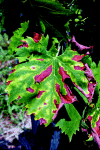Molecular and phenotypic characterisation of novel Phaeoacremonium species isolated from esca diseased grapevines
- PMID: 20396582
- PMCID: PMC2846134
- DOI: 10.3767/003158508X374385
Molecular and phenotypic characterisation of novel Phaeoacremonium species isolated from esca diseased grapevines
Abstract
Petri disease and esca are very destructive grapevine decline diseases that occur in most countries where grapevine (Vitis vinifera) is cultivated. Phaeoacremonium species are among the principal hyphomycetes associated with symptoms of the two diseases, producing a range of enzymes and phytotoxic metabolites. The present study compared the phylogeny of a global collection of 118 Phaeoacremonium isolates from grapevines, in order to gain a better understanding of their involvement in Petri disease and esca. Phylogenetic analyses of combined DNA sequence datasets of actin and beta-tubulin genes revealed the presence of 13 species of Phaeoacremonium isolated from esca diseased grapevines. Phaeoacremonium aleophilum was the most frequently isolated species with an incidence up to 80 % of all isolates investigated. Species previously described mainly as human pathogenic species, namely Pm. alvesii, Pm. griseorubrum and Pm. rubrigenum are newly reported on grapevine from Turkey, Italy and Croatia, respectively. Phaeoacremonium viticola and Pm. scotyli represent new records for Italy, as well as Pm. mortoniae for Hungary and Croatia. In addition, four new species of Phaeoacremonium, namely Pm. croatiense, Pm. hungaricum, Pm. sicilianum and Pm. tuscanum are newly described from grapevine based on morphology, cultural characteristics, as well as molecular phylogeny.
Keywords: Phaeoacremonium; actin; esca; morphology; phylogeny; β-tubulin.
Figures





 New species described in this study;
New species described in this study;  Human pathogenic species;
Human pathogenic species;  Species isolated from grapevine; * Human pathogenic species newly reported from grapevine.
Species isolated from grapevine; * Human pathogenic species newly reported from grapevine.
 New species described in this study;
New species described in this study;  Human pathogenic species;
Human pathogenic species;  Species isolated from grapevine; * Human pathogenic species newly reported from grapevine.
Species isolated from grapevine; * Human pathogenic species newly reported from grapevine.




Similar articles
-
Phaeoacremonium italicum sp. nov., associated with esca of grapevine in southern Italy.Mycologia. 2014 Nov-Dec;106(6):1119-26. doi: 10.3852/14-080. Epub 2014 Aug 24. Mycologia. 2014. PMID: 25151999
-
Occurrence of Togninia fraxinopennsylvanica on Esca-Diseased Grapevines (Vitis vinifera) and Declining Ash Trees (Fraxinus latifolia) in California.Plant Dis. 2005 May;89(5):528. doi: 10.1094/PD-89-0528C. Plant Dis. 2005. PMID: 30795441
-
Cadophora sabaouae sp. nov. and Phaeoacremonium Species Associated with Petri Disease on Grapevine Propagation Material and Young Grapevines in Algeria.Plant Dis. 2021 Nov;105(11):3657-3668. doi: 10.1094/PDIS-11-20-2380-RE. Epub 2021 Nov 18. Plant Dis. 2021. PMID: 34096766
-
Phaeoacremonium: from esca disease to phaeohyphomycosis.Fungal Biol. 2015 Sep;119(9):759-83. doi: 10.1016/j.funbio.2015.06.004. Epub 2015 Jun 23. Fungal Biol. 2015. PMID: 26321726 Review.
-
Phytotoxins produced by fungi associated with grapevine trunk diseases.Toxins (Basel). 2011 Dec;3(12):1569-605. doi: 10.3390/toxins3121569. Epub 2011 Dec 20. Toxins (Basel). 2011. PMID: 22295177 Free PMC article. Review.
Cited by
-
A Survey of Trunk Disease Pathogens within Citrus Trees in Iran.Plants (Basel). 2020 Jun 16;9(6):754. doi: 10.3390/plants9060754. Plants (Basel). 2020. PMID: 32560035 Free PMC article.
-
Coniochaeta (Lecythophora), Collophora gen. nov. and Phaeomoniella species associated with wood necroses of Prunus trees.Persoonia. 2010 Jun;24:60-80. doi: 10.3767/003158510X500705. Epub 2010 Apr 1. Persoonia. 2010. PMID: 20664761 Free PMC article.
-
A Panoramic View on Grapevine Trunk Diseases Threats: Case of Eutypa Dieback, Botryosphaeria Dieback, and Esca Disease.J Fungi (Basel). 2022 Jun 1;8(6):595. doi: 10.3390/jof8060595. J Fungi (Basel). 2022. PMID: 35736078 Free PMC article. Review.
-
Fungal Grapevine Trunk Diseases in Romanian Vineyards in the Context of the International Situation.Pathogens. 2022 Sep 2;11(9):1006. doi: 10.3390/pathogens11091006. Pathogens. 2022. PMID: 36145437 Free PMC article. Review.
-
Phaeoacremonium tuscanicum and Phaeoacremonium indicum sp. nov. associated with subcutaneous phaeohyphomycosis.Mycology. 2024 Feb 12;15(1):129-135. doi: 10.1080/21501203.2024.2312917. eCollection 2024. Mycology. 2024. PMID: 38558841 Free PMC article.
References
-
- Adalat K, Whiting C, Rooney S, Gubler WD. 2000. Pathogenicity of three species of Phaeoacremonium spp. on grapevine in California. Phytopathologia Mediterranea 39: 92 – 99
-
- Calzarano F, Di Marco S. 2007. Wood discoloration and decay in grapevines with esca proper and their relationship with foliar symptoms. Phytopathologia Mediterranea 46: 96 – 101
-
- Carbone I, Kohn LM. 1999. A method for designing primer sets for speciation studies in filamentous ascomycetes. Mycologia 91: 553 – 556
-
- Crous PW, Gams W. 2000. Phaeomoniella chlamydospora gen. et comb. nov., a causal organism of Petri grapevine decline and esca. Phytopathologia Mediterranea 39: 112 – 118
LinkOut - more resources
Full Text Sources
Molecular Biology Databases
